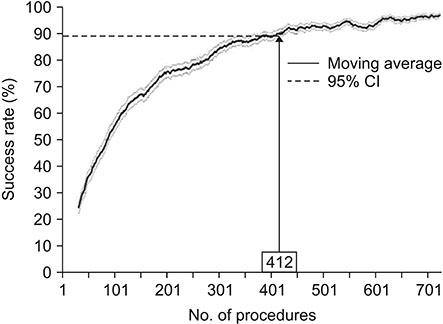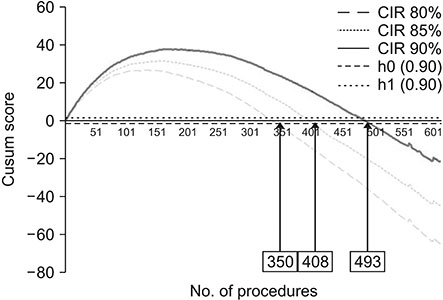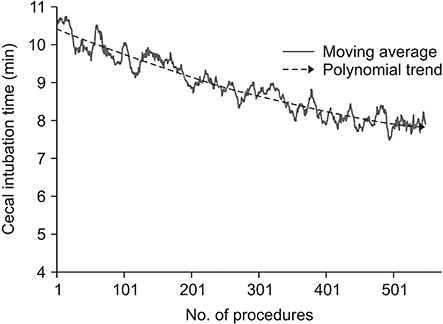Ann Surg Treat Res.
2018 Oct;95(4):169-174. 10.4174/astr.2018.95.4.169.
Colonoscopy learning curves for colorectal surgery fellow trainees: experiences with the 15-year colonoscopy training program
- Affiliations
-
- 1Center for Colorectal Cancer, Research Institute and Hospital, National Cancer Center, Goyang, Korea. gsgsbal@ncc.re.kr
- 2Innovative Medical Engineering & Technology, Division of Convergence Technology, Research Institute and Hospital, National Cancer Center, Goyang, Korea.
- KMID: 2421194
- DOI: http://doi.org/10.4174/astr.2018.95.4.169
Abstract
- PURPOSE
This study aimed to analyze the learning curves for colorectal surgery fellows in a colonoscopy training program.
METHODS
Between May 2003 and February 2017, 60 surgical fellows joined our 1-year colonoscopy training program as trainees and performed 43,784 cases of colonoscopy. All trainees recorded their colonoscopy experiences prospectively into the database. After excluding 6 trainees, who had experience with performing more than 50 colonoscopies before participating in our training program or who discontinued our training program with experience performing less than 300 colonoscopies, this study included 54 trainees who had performed 39,539 colonoscopy cases. We analyzed the cecal intubation rate (CIR) and cecal intubation time (CIT) using the cumulative sum (Cusum) technique and moving average method to assess the technical colonoscopy competence.
RESULTS
Overall, the CIR by the trainees was 80.7%. The median number of cases of colonoscopy performed during the training period for each trainee was 696 (range, 322-1,669). The trainees were able to achieve a 90% CIR with 412 and 493 procedures when analyzed using the moving average and the Cusum, respectively. Using the moving average method, CIRs after 150, 300, and 400 procedures were 67.0%, 84.1%, and 89.2%, respectively. The CIT of trainees continuously decreased until 400 successful cases. Median CITs were 9.4, 8.3, and 7.4 minutes at 150, 300, and 400 successful cases, respectively.
CONCLUSION
We found that more than 400 cases of experience were needed for technical competence in colonoscopy. Continuous teaching and monitoring is required until trainees become sufficiently competent.
Keyword
MeSH Terms
Figure
Cited by 1 articles
-
Guidelines for accreditation of endoscopy units: quality measures from the Korean Society of Coloproctology
Rumi Shin, Seongdae Lee, Kyung-Su Han, Dae Kyung Sohn, Sang Hui Moon, Dong Hyun Choi, Bong-Hyeon Kye, Hae-Jung Son, Sun Il Lee, Sumin Si, Won-Kyung Kang
Ann Surg Treat Res. 2021;100(3):154-165. doi: 10.4174/astr.2021.100.3.154.
Reference
-
1. Lee SH, Chung IK, Kim SJ, Kim JO, Ko BM, Hwangbo Y, et al. An adequate level of training for technical competence in screening and diagnostic colonoscopy: a prospective multicenter evaluation of the learning curve. Gastrointest Endosc. 2008; 67:683–689.
Article2. Rex DK, Bond JH, Winawer S, Levin TR, Burt RW, Johnson DA, et al. Multi-Society Task Force on Colorectal Cancer. Quality in the technical performance of colonoscopy and the continuous quality improvement process for colonoscopy: recommendations of the U.S. Multi-Society Task Force on Colorectal Cancer. Am J Gastroenterol. 2002; 97:1296–1308.
Article3. Ward ST, Mohammed MA, Walt R, Valori R, Ismail T, Dunckley P. An analysis of the learning curve to achieve competency at colonoscopy using the JETS database. Gut. 2014; 63:1746–1754.
Article4. Brahmania M, Park J, Svarta S, Tong J, Kwok R, Enns R. Incomplete colonoscopy: maximizing completion rates of gastroenterologists. Can J Gastroenterol. 2012; 26:589–592.
Article5. Chung JI, Kim N, Um MS, Kang KP, Lee D, Na JC, et al. Learning curves for colonoscopy: a prospective evaluation of gastroenterology fellows at a single center. Gut Liver. 2010; 4:31–35.
Article6. Koch AD, Haringsma J, Schoon EJ, de Man RA, Kuipers EJ. Competence measurement during colonoscopy training: the use of self-assessment of performance measures. Am J Gastroenterol. 2012; 107:971–975.
Article7. Park Y, Yong YG, Yun SH, Jung KU, Huh JW, Cho YB, et al. Learning curves for single incision and conventional laparoscopic right hemicolectomy: a multidimensional analysis. Ann Surg Treat Res. 2015; 88:269–275.
Article8. Parry BR, Williams SM. Competency and the colonoscopist: a learning curve. Aust N Z J Surg. 1991; 61:419–422.
Article9. Romagnuolo J, Enns R, Ponich T, Springer J, Armstrong D, Barkun AN. Canadian credentialing guidelines for colonoscopy. Can J Gastroenterol. 2008; 22:17–22.
Article10. Johna S, Klaristenfeld D. Surgery resident training in endoscopy: the saga continues. Arch Surg. 2011; 146:899–900.11. Guidelines for credentialing and granting privileges for gastrointestinal endoscopy. American Society for Gastrointestinal Endoscopy. Gastrointest Endosc. 1998; 48:679–682.12. Cass OW, Freeman ML, Peine CJ, Zera RT, Onstad GR. Objective evaluation of endoscopy skills during training. Ann Intern Med. 1993; 118:40–44.
Article13. Rex DK. Still photography versus videotaping for documentation of cecal intubation: a prospective study. Gastrointest Endosc. 2000; 51(4 Pt 1):451–459.
Article14. Marshall JB, Barthel JS. The frequency of total colonoscopy and terminal ileal intubation in the 1990s. Gastrointest Endosc. 1993; 39:518–520.
Article15. Waye JD, Bashkoff E. Total colonoscopy: is it always possible. Gastrointest Endosc. 1991; 37:152–154.
Article16. Hull T, Church JM. Colonoscopy--how difficult, how painful? Surg Endosc. 1994; 8:784–787.17. Church JM. Complete colonoscopy: how often? And if not, why not? Am J Gastroenterol. 1994; 89:556–560.18. Bernstein C, Thorn M, Monsees K, Spell R, O'Connor JB. A prospective study of factors that determine cecal intubation time at colonoscopy. Gastrointest Endosc. 2005; 61:72–75.
Article19. Kim WH, Cho YJ, Park JY, Min PK, Kang JK, Park IS. Factors affecting insertion time and patient discomfort during colonoscopy. Gastrointest Endosc. 2000; 52:600–605.
Article
- Full Text Links
- Actions
-
Cited
- CITED
-
- Close
- Share
- Similar articles
-
- Analysis of adenoma detection rate of colonoscopy among trainees
- Training in Endoscopy: Colonoscopy
- Colonoscopy education for surgical residents in Korea: a national survey of Korean Surgical Skill Study Group
- Post-colonoscopy Colorectal Cancer: Causes and Prevention of Interval Colorectal Cancer
- Quality is the Key for Emerging Issues of Population-based Colonoscopy Screening




